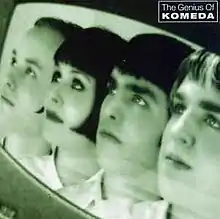| The Genius of Komeda | ||||
|---|---|---|---|---|
 | ||||
| Studio album by | ||||
| Released | 1996 | |||
| Recorded | 1995 | |||
| Genre | Pop, Rock | |||
| Label | North of No South, Minty Fresh | |||
| Producer | Komeda Pelle Henricsson Eskil Lövström | |||
| Komeda chronology | ||||
| ||||
| Review scores | |
|---|---|
| Source | Rating |
| AllMusic | |
| Pitchfork Media | 6.6/10[2] |
The Genius of Komeda is the second full-length studio album by Swedish band Komeda. Released in 1996, this was the first Komeda release sung in English. Licensed from Swedish record label North of No South to Minty Fresh, this was Komeda's first record to be given an international release.
The album was packaged as if it were a compilation with a (mainly) fake back catalogue based on an idea by the band's graphic designers.[3] In a 2020 interview with the Jeffrey Podcast, bass player Marcus Holmberg chose this as his favourite Komeda album.[3]
Its pop/rock sound brought about comparisons to Minty Fresh labelmates The Cardigans and also Stereolab.
Track listing
All songs written by Komeda
- "More is More"
- "Fire"
- "Rocket Plane (Music on the Moon)"
- "Boogie Woogie / Rock'n'Roll"
- "Disko"
- "Top Star"
- "Light o' My Life"
- "If"
- "Frolic"
- "In Orbit"
- "Arbogast"
- "New New No"
References
- ↑ The Genius of Komeda at AllMusic
- ↑ "Archived copy". www.live-wire.com. Archived from the original on 11 October 1999. Retrieved 10 August 2022.
{{cite web}}: CS1 maint: archived copy as title (link) - 1 2 Development, PodBean. "Episode 4a - a Jeffrey Extra: Marcus Holmberg (Komeda) interview". jeffreypodcast.podbean.com. Retrieved 2020-08-10.
This article is issued from Wikipedia. The text is licensed under Creative Commons - Attribution - Sharealike. Additional terms may apply for the media files.